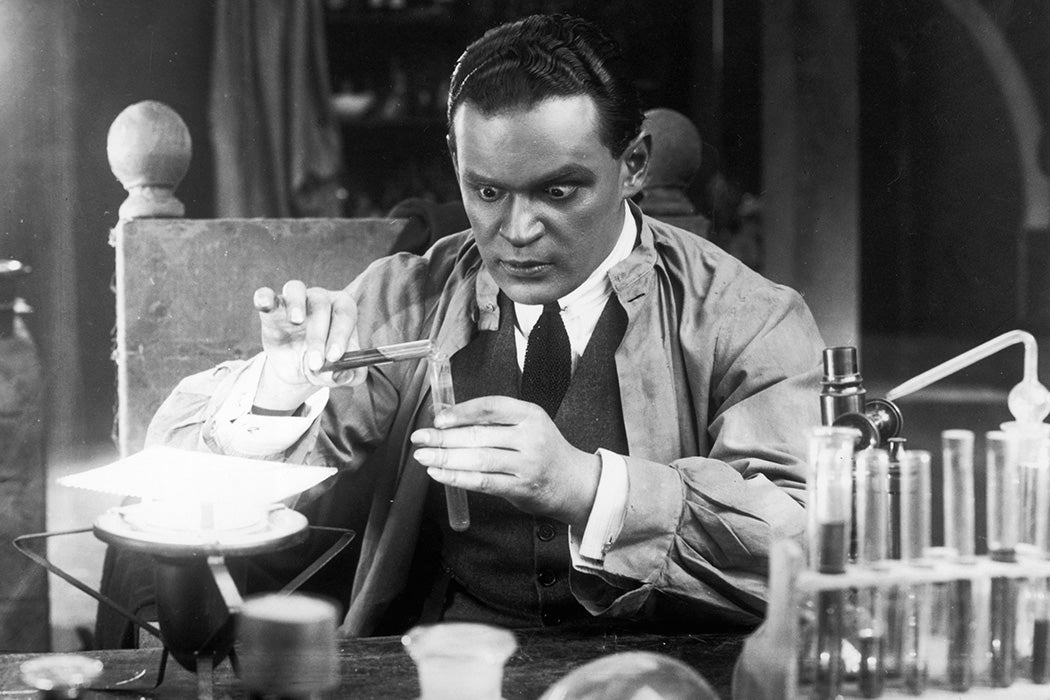With a flash of lightning and a crash of thunder, a mad cackle rings out from a dark laboratory. Inside, a frail, large-lobed scientist hunches over his latest abomination. The archetype of the mad genius—a malevolent, weak-bodied creature with an oversized head—didn’t come out of nowhere. It was set in place by early science fiction authors—most notably H.G. Wells, in books like The Island of Dr. Moreau (1896) and War of the Worlds (1897–98). And, according to humanities scholar Anne Stiles, writers like Wells were taking inspiration from one form of evolutionary theory.
Stiles argues that “the now-familiar trope of the mad scientist…traces its roots to the clinical association between genius and insanity that developed in the mid-nineteenth century.” In the early 1800s, the Romantics saw the condition as a “mystical phenomenon beyond the reach of scientific investigation.” The Victorians took a more detached and critical approach. “Rather than glorifying creative powers, Victorians pathologized genius and upheld the mediocre man as an evolutionary ideal,” Stiles writes. “All aberrations from the norm could be seen as pathological, including extreme intelligence.”
For the source of many of these ideas, Stiles points to the Mind, the first English journal dedicated to psychology and philosophy, which often hosted popular discussions of genius and insanity. In these papers, scientists, philosophers, and physicians provided an evolutionary rationale for associating genius with things like madness, degeneracy, and infertility. In his essay “The Insanity of Genius” (1891), Scottish philosopher John Ferguson Nisbet defined “genius” as “a kind of hereditary, degenerate brain condition symptomatic of ‘nerve disorder’ which ‘runs in the blood.'” He declared that “genius, insanity, idiocy, scrofula, rickets, gout, consumption, and the other members of the neuropathic family of disorders” reveal “want of equilibrium in the nervous system.” Genius and gout: truly, two sides of the same coin.
In the pages of the Mind, scientists argued (using what Stiles calls “surprisingly unscientific” rationale) that “mankind had evolved larger brains at the expense of muscular strength, reproductive capacity, and moral sensibility.” Scientists worried about the potential to pass genius (and, by extension, insanity) on to future generations. Of course, many also conceded that “extraordinary men were relatively unlikely to reproduce,” with one scientist blaming “shy, odd manners, often met with in young persons of genius,” according to Stiles.
But what if these nerds did reproduce? Working from Lamarckian theories of evolution, these scientists hypothesized that the more humans relied on their brains, the weaker the rest of their bodies would become. “One possible conclusion of rapid Lamarckian brain evolution, then, was a species of morally insane beings boasting enormous cerebrums and minuscule bodies,” writes Stiles.
Weekly Newsletter
Stiles uses early stories by H.G. Wells as a case study for the cross-fertilization between literature and scientific ideas. In his writings, Wells imagines the distant evolutionary future of mankind. With the mad-scientist villain of The Island of Dr. Moreau, Wells shares a “vision of great thinkers as diseased victims of biological determinism,” according to Stiles. Stiles also cites Wells’s The First Men in the Moon (1901), in which the author “depicts brains becoming steadily larger and more powerful as bodies grow smaller and more useless, emotions increasingly muted, and conscience all but silenced.”
This nightmarish vision of massively overevolved brains makes appearances across Wells’s body of work, taken to the extreme with his vision of malevolent, unfeeling extraterrestrials in War of the Worlds. Thankfully, most modern scientists no longer view this archetype as a terrifying potential future for humanity. Nowadays, the unfeeling mad scientist is much more likely to be found in movies and literature, not in the pages of academic journals.







